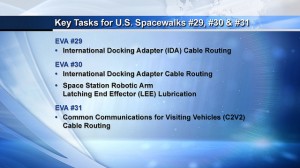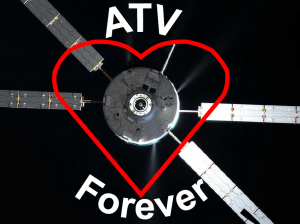A walk around space with Barry and Terry
After 91 days of living in their new home in space they finally went outside Not to catch some fresh air of course…that would be quit dangerous!
US astronauts Barry Wilmore and Terry Virts commenced the first of three spacewalks last Saturday. It was Barry’s second spacewalk after his first one last October and Terry’s first.
The two astronauts, already nicknamed the ‘cable guys’ have to rig cables on the International Space Station for new docking ports for commercial and international spacecraft called International Docking Adapters or IDA. They will be delivered on two Space-X Dragon spacecraft in the near future.
The adapters are built by Boeing and will arrive separately as Dragon cargo that will dock to the Harmony Module or Node 2. Node 2 already has two Pressurized Mating Adapter (PMA) which are used to connect spacecraft and modules with different docking mechanisms. They resemble tunnels that connect to spacecraft.

The tasks for the U.S. spacewalks #29, #30, #31.
The goal will then be to link each International Docking Adapters to a Pressurized Mating Adapter … imagine doing it with Lego, more or less!
But like with Lego there is a possibility that one piece, in this case the Pressurized Mating Adapter could be better used elsewhere. That is the case with PMA-3. The first International Docking Adapter is relatively easy to install: it is connected to PMA-2, which is installed on the Harmony Module facing the direction the Space Station moves.
The second International Docking Adapter requires more work. The international adapter will be connected to PMA-3 but it first has to be moved from Node 3 Harmony to Node 2 Unity to face towards space.
Why all this work? The new docking adapters will be used to welcome the new commercial cargos from Space-X and Boeing , starting most likely from the last part of 2017. In the long run the two new Adapters will allow the Space Station to host one more crew from the present six.
In the meantime new cargo arrived at the Space Station bringing food, supplies and new hardware for the experiments.
It has been a busy period for the astronauts living on the ISS that in a very short period has seen the arrival of Dragon and the depart of both Dragon and the last ever European cargo spaceship ATV-5. Progress 58, the Russian cargo just arrived at the Station, will stay docked to the Station until next August.
The astronauts have a lot of work to do in any case: two more spacewalks are expected this week and a new crew will soon arrive to start Expedition 43.
Stefano Sandrelli
Cover image: Terry Virts as seen from the Cupola of the ISS and photographed by Samantha Cristoforetti on Feb.21, 2015. Credits: ESA/NASA
For more pics of the U.S. spacewalk #29: https://www.nasa.gov/mission_pages/station/expeditions/expedition42/gallery.html#.VOtMxvmG-So
23/02/2015





